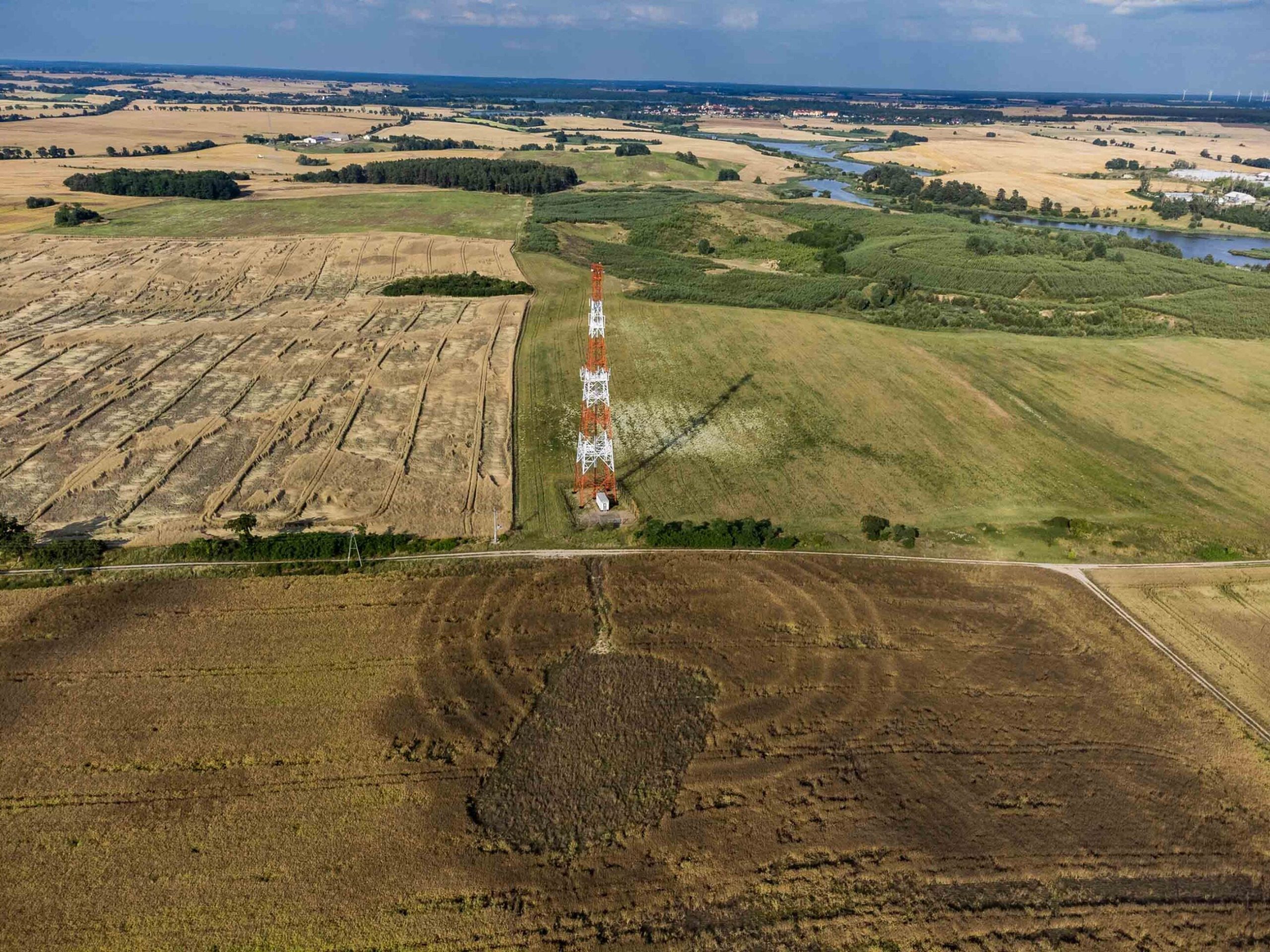Mysterious crop circles and a mystery from 7,000 years ago

Rondel in Nowe Objezierze in Western Pomerania is undoubtedly one of the most interesting archaeological discoveries of recent years. Every year, the owner of the field sowed wheat or rapeseed here, only aerial photography made it possible to see what was not visible from the ground.
The characteristic crop circles in many people evoke one association: aliens and a story worthy of the TV series “The X-Files”. In a field in Nowe Objezierze, a small village south of Szczecin, they were spotted by a local motor paraglider, Norbert Pająk from Chojna. But at the same time, archaeologist Dr. Marcin Dziewanowski also noticed strange traces. The latter, in turn, was looking at satellite photos of the area.
When Norbert Pająk took the first photographs of the circles, he immediately went to the owner of the field. But from the ground, they couldn’t see much. The circles can be seen from above and, as it turned out later, their clarity depends on many factors: they are most pronounced in wheat and when it is dry. The photos of the paraglider immediately made a sensation on the web. Many people suggested that the circles were the result of “some radiation” because there is a broadcasting tower next to it. However, archaeologists knew right away – there may be a rondel, a characteristic building erected, as later confirmed by research, 4800 years before Christ.
A place of ceremony and celebration
A year later, archaeologists from Gdańsk and Szczecin began research in Nowe Objezierze. What exactly is a saucepan? The association with the vessel is correct, because the name refers to its shape.
– Rondels were characterized by the presence of concentric ditches with a characteristic V-shaped cross-section, the continuity of which was interrupted by “gates” leading to the undeveloped interior, additionally surrounded by a wooden and earth rampart, which is traced by three concentric foundation grooves. In Nowe Objezierze, the largest ditch formed a circle with a diameter of 112-113 m, and the next three: 99 m, 83 m and 69 m. The width of these ditches reached 3 m and a depth of 2 m – explains Prof. Lech Czerniak from the University of Gdańsk, who heads the research in Nowe Objezierze.
The aforementioned rampart of the circle protected the inner square with a diameter of 48 m, which was not built-up and created a space within which ceremonies gathering the local community of farmers and breeders were held for nearly three centuries.
– Rondels served social purposes, they were a meeting place for the then inhabitants of these areas. Events important to them, celebrations, some rituals took place here – says prof. Melanoma.
It is worth noting that so far nearly 200 roundels have been located throughout Europe. Most in Austria, but also in Germany, Hungary and the Czech Republic. – There are a lot of roundels in Europe and they have been well researched, although quite one-sidedly. The focus was mainly on the issues of differences in the layout of these objects and the possibility of “reading” whether the rondel gates indicate directions of astronomical significance – e.g. by indicating the sunset on the day of the winter solstice. We decided to try to answer the question: how long and how did rondelles function? – says Lech Czerniak.
Sensations from the New Objezierz
In Poland, a dozen or so roundels have been discovered so far (all thanks to aerial photography). However, the one in Nowe Objezierze is unique in many ways.
We can even talk about sensational discoveries here – emphasizes prof. Melanoma.
There are several sensations. Firstly, thanks to C14 dating, we know that the building functioned for about 250 years. As archaeologists explain, this means that it was used by as many as ten successive generations. Secondly, despite being located on the farthest northern outskirts of what was then a farming community, it was built at the same time as similar structures along the Danube and upper Elbe. The number of ditches surrounding this object is also unique, because most of the known roundels have one or two ditches. And here’s another sensation: archaeologists have no doubt that the four ditches that today form the characteristic circles did not function simultaneously.
What’s more, they were cyclically dug up and buried, thus marking the beginning and end of the celebration. The accompanying huge effort probably gave a sense of co-creation of the object, repeating an act performed in “old times” by the ancestors – says prof. Melanoma. And as he explains, after the renovation of the facility, a feast was held during which cow meat was eaten and stagings recalling the memory of important events and figures from the past took place.
Why were new ditches created? Perhaps it was related to some outstanding individual, perhaps a person who led the ceremonies held there? When one such person died, perhaps another was chosen and thus a new ditch was built? – wonders Dr. Agnieszka Matuszewska from the University of Szczecin, who also studies the saucepan.
Dr. Matuszewska emphasizes that as part of the research project, scientists tried to look at the pan from the social point of view and through the prism of people who lived here at the time. However, today it is difficult to say unequivocally what exactly the ceremonies that took place in a saucepan were about.
But we have no doubts about the ceremonial, ritual character of the pan – says the researcher.
As he explains, the very shape made the community come together, separated from what was outside. “In addition, we found bones of cattle in the ditches, including skulls, which we interpret as deliberate deposits accompanying ceremonies held on a saucepan. It is worth noting that cattle had a share of more than 90% of the total bones, which – in comparison with the structures of waste after meat consumption in the settlements, where the remains of a sheep, goat and pig also have a significant share – proves their unique role in rituals. These skulls must have been related to some rituals, adds Agnieszka Matuszewska.
He also reminds that thanks to aerial photography and drone photos, the first house belonging to the builders of the rondel was found (later, several more houses were discovered in the area). – It is a characteristic structure from over 7,000 years ago, with a trapezoidal foundation ditch, dating from the same period as the saucepan – he says. The photos from above clearly show that the pan itself was on a hill and must have been visible to people living in the area.
How a fragment of a rondel was built today
On January 1, 2023, the documentary “Rondele – a great riddle from 7000 years ago” had its premiere. As its creator, Krzysztof Paluszyński, emphasized, a fragment of the contemporary world was recreated for the purposes of the documentary.
A unique archaeological experiment was carried out. Scientists in cooperation with filmmakers in one of the fields near Nowe Objezierze decided to reconstruct a fragment of the building. It’s Prof. Czerniak watched over the details. – We realized how titanic work these people had to do to create something like this using the tools they knew. Just cutting down, preparing and transporting about a thousand trees that were needed for construction could take even several years – says the archaeologist.
And here another important issue arises. – After all, these people worked hard every day to feed themselves, to make supplies, they were engaged in animal husbandry, they were farmers. How important the saucepan must have been to them, since so much effort had gone into building it. Only when we realize this, we can guess the role of rondels as places of assembly and rituals, where family groups living in scattered farms on a daily basis could meet, renewing the sense of community and security. Rondels in their huge size were also a signal to strangers that the lands in the area had been occupied for centuries, and the inhabitants had the strength to defend their rights – says prof. Melanoma.
For the needs of the film, several dozen actors and extras recreated scenes that could accompany the building of a saucepan and the everyday life of the then inhabitants of these areas. Everything was consulted with rondel researchers.
– I admit that we had one doubt during the making of the film. It’s about disheveled women’s hair. Did they really look like this, or is it just our reproduced stereotype of disheveled and neglected people from the Stone Age? Prof. Czerniak even tried to look for any finds of combs from that time… The question about women’s hairstyles from 7,000 years ago remains open, says Agnieszka Matuszewska.
How could a saucepan function for nearly 300 years?
The research itself and the experiment consisting in reconstructing a fragment of the building showed something else. As Prof. Czerniak, there are disputes among archaeologists whether rondelles could actually function for more than 20-30 years. – They point out that the inside of the saucepan was closed by a wooden structure, after which the foundation grooves have been preserved without any traces of pole replacement, and the wood, even with today’s chemical protection, is unstable – he explains.
So we turned the question around. If we have irrefutable evidence in the form of radiocarbon dating that the facility was in operation for about 250 years, then one should consider what can be done with the technology of that time to make the structure last so long?
– And we started with the analysis of the structures of wooden houses built by Neolithic farmers, which were plastered with clay and secured with lime, and ended with the embankments of medieval hillforts, where wood covered with a thick layer of clay has survived to our times. Therefore, we believe that the structure did not consist only of wooden poles, but they were only a skeleton hidden under a clay embankment, which made it possible to pile up the clay and cover it with a roof protecting it from erosion caused by rain and wind – explains Prof. Melanoma.
Speaking of the New Objezierze, it should also be mentioned that archaeologists conducted traditional excavations only on a selected part of it (it is clearly visible from above – the research site is a characteristic rectangle interrupting the circles). As the scientists say, the idea was to examine the pan, but at the same time leave most of it untouched in anticipation of even more modern methods and possibilities for studying the past that the future will undoubtedly bring.
Every year, the field in Nowe Objezierze is carefully watched from his paraglider by Norbert Pająk. When the circles in the field start to become visible, he immediately alerts the archaeologists. This is a very important signal for them. Since the saucepan is visible, perhaps traces of other objects from thousands of years ago will also become visible.





